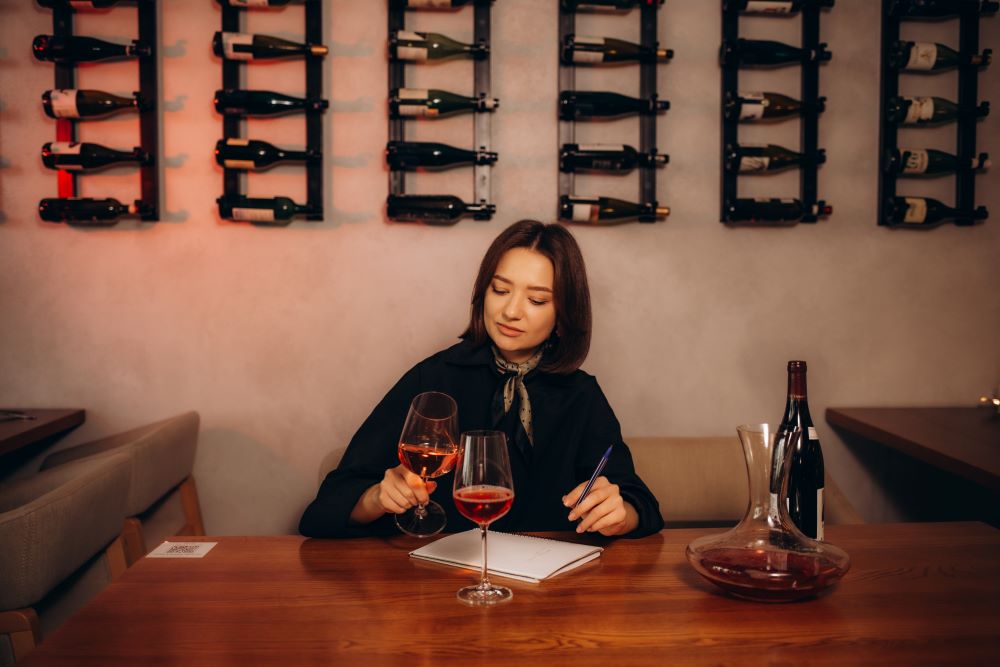Being able to take notes of how your favourite wines taste, smell, and feel is like creating an art. Just like art can make a place more alive, your wine tasting notes can elevate your appreciation for the drink. So, whether you’re a wine expert who knows almost all the details about your favourite wines or a novice who has yet to explore wines you can cross and compare, learning the art of writing wine tasting notes is essential to improve your overall wine experience.
In this article, you’ll learn the basics of tasting wines and the effective and efficient ways to transform these tastes into notes.
What are Wine Tasting Notes?
Wine tasting notes are like a journal, but instead of indicating general information about how your day goes by, they contain your specific wine experiences. They are your observations and descriptions of crucial wine areas: appearances, aromas, tastes, and finishes.
According to an article by Surely, tasting notes can be simply about the “5 S’s of wine tasting,” which are see, swirl, sniff, sip, and savour. They record your sensory experience, helping you remember wines you like and don’t like.
Besides recall, wine tasting notes can also guide you in your exploration to finding, understanding, and improving your palate. It is also a great way to bond with other wine enthusiasts by sharing notes, comparing, and giving and receiving recommendations.
The Basics of Wine Tasting
If you’re a wine connoisseur, you already know that to enjoy a wine fully, you must have a technique because tasting a wine is not simply drinking. It’s an experience. Thus, before digging deeper into wine tasting notes, let’s discuss first what you need to know about wine tasting.
Visual Wine Assessment
Assessing a wine’s visual goes beyond aesthetics; it reveals much information about its age, quality, and flavour profile. But how do you examine that? By checking the wine’s colour, clarity, and viscosity.
You can check the colour by holding your glass up to the light.
Meanwhile, the wine’s clarity means the brightness or cloudiness of wine, and viscosity or the legs that form on the glass after swirling can hint at the alcohol content and sweetness level.
Olfactory Examination
Wines’ aromas are like your windows through the flavours you’ll experience. They give you hints of the taste even without the actual sipping. This is why you must know how to properly smell the wine’s aroma.
After pouring your choice of wine into the glass, gently swirl it to release the drink’s aromatic compounds.
Wine Tasting Process
Now, to the actual tasting. Drinking wine is more than just sipping; you must fully engage with it. To do this, swirl the wine around your mouth and let your taste buds tell you the primary flavours, acidity, tannins, and body.
Analyzing Wine Aftertaste
Wine tasting does not end in the actual tasting. You must also be mindful of the aftertaste or the lingering flavour after drinking the wine.
The aftertastes are usually an indicator that wine is of high quality. For instance, a long, pleasant finish is often a sign of fine wines, while a harsh finish might indicate that the wine has a less refined overall character.

Creating Wine Tasting Notes
Writing notes in tasting wines can be intimidating at first, but once you understand the process, it’ll be less daunting, and all you can think about is how they can refine your palate and articulate your preferences.
In this section, you’ll learn what to include in your notes, essential wine terminologies, and tips for making notes consistent.
What to Include in Your Wine Tasting Notes
As mentioned earlier, several aspects of wine are crucial in understanding its totality: appearance, aroma, taste, and finish. These four are also what should be the primary details in your notes. Let’s discuss them one by one.
Visual Aspects
In the art of tasting wines, eyes are the first ones that help you have an impression. So, start by recording the colour, intensity or clarity, and viscosity. Wine’s appearance reveals several facts about the drink, such as the grapes used and age.
White wines darken with age, while red wines lose vibrant colour. On the other hand, bright wines tell you that they are well-filtered. So, if a wine appears cloudy, it can suggest it is older or unfiltered. As per viscosity, if you see more pronounced legs, the wine has a higher alcohol content or residual sugar.
Aromas
After the visuals, your next focus should be on the aromas categorised into primary, secondary, and tertiary scents.
To better understand the three, here are the things you should take note of:
- Primary: The scent directly from the grapes, which can have fruity, floral, or herbal aromas.
- Secondary: This scent develops during winemaking and may include toasty or yeasty notes from fermentation.
- Tertiary: The scent that introduces complex aromas as they emerge through ageing the wine inside the bottle.
Taste
You must note the exact flavours in the actual tasting, including the sweetness or bitterness, acidity, tannins, and overall balance.
Questions to ask yourself when tasting a wine are: “Is the acidity crisp and refreshing, or does the wine’s sweetness balance it? Are the tannins smooth or astringent?”
Identifying the answers to these will help you determine the wine’s character and complexity and help you set it apart from other wines.
Finish
Lastly, you should also describe the finish of the wine after taking a sip. You must consider its length and complexity, indicating the wine’s quality and refinement.
Complex wines also give you different impressions, like they can be fruity at first but eventually turn into a spicy or earthy finish. Taking notes of these instances will help you select wines that match your taste.
Wine Terminology and Descriptors You Need to Know
Understanding common wine terminologies and descriptors can make your notes more insightful and help you write your experiences accurately. Familiarise yourself with some of these common words many wine enjoyers use:
- Terroir: Wine’s geographical origins, like soil, climate, and landscape.
- Body: The weight and texture of the wine in your mouth.
- Bouquet: Complex aromas in a wine, primarily used to describe aged wine’s smell.
- Crisp: Used to describe a wine’s refreshing, bright acidity, lively, and clean taste.
- Complex: If a wine has multiple layers of flavours and aromas.
- Velvety: If a wine gives off a silky, smooth texture.
- Blackberry: A common descriptor that points out a fruity or dark berry flavour in red wines.
- Vintification: The entire winemaking process.
- Leather: A scent that gives the wine an earthy and musky aroma.
- Balance: When acidity, sweetness, tannins, and alcohol harmonise in your mouth.
Tips for Consistent and Useful Wine Tasting Notes
As a wine enthusiast, creating wine tasting notes to every wine you’ve tried can help you make a portfolio of your favourites. So, to make your notes more consistent and valuable, you can check out these tips below:
- Use a dedicated app as your tasting journal.
- Review and compare your notes.
- Cleansing your palate before tasting a wine could help you write accurate notes.
- Take as many sips as you need so you can specify the details of your wine experience.
- It’s okay to ask for experts’ thoughts.
- Try varieties of wine so you can expand your palate.
Mastering the Art of Wine Tasting Notes
Taking detailed notes while tasting wines is not just about recording your experience; it’s a powerful tool for deepening your appreciation and refining your palate.
This is why elevating your wine tasting skills and refining your note-taking practice will enrich your wine journey. And what’s a better way to explore and take notes on some exceptional wines than visiting a trusted shop like Crystal Wines?
We are a leading wine wholesaler in Singapore, trusted by over 70 wine agencies worldwide. The best part? You can shop with us in the comfort of your home as we offer wine delivery within Singapore.
